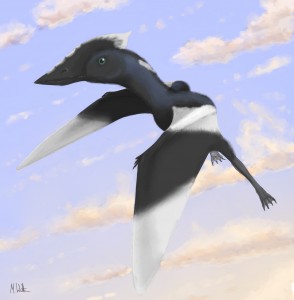New Flying Reptile Named after Girl who Found the Fossils
For Daisy Morris and her parents a walk along the beach on a winter’s day was going to turn out to be a rather special event, for the family spotted some fossils that represent a new species of flying reptile. The discovery made back in November 2008 has led to young Daisy, who was nearly five years old at the time of the fossil find, having the honour of having a prehistoric animal named after her. The new pterosaur is called Vectidraco daisymorrisae. The name means dragon from the Isle of Wight (after Vectis – the old name for the island), the specific name honours Daisy.
Pterosaur
An Illustration of Vectidraco daisymorrisae
Picture credit: Mark Witton
The Morris family spotted a collection of small bones that had weathered out of a block of rock and now lay on a scree slope near the foot of the cliff immediately west of Atherfield Point (Isle of Wight), if the family had not discovered the fossils, this precious prehistoric material would have most likely have been lost for ever being washed away at the next high tide.
Daisy Morris – A New Pterosaur Named
Identified as a specimen from the basal part of the marine Atherfield Clay Formation of the Lower Greensand Group, this new pterosaur was probably about the size of a large crow and its discovery has helped palaeontologists to understand a little better the diversity of European pterosaurs from the Early Cretaceous. The fossil material has been dated to the Aptian faunal stage of the Cretaceous and it has been estimated that this thirty-five centimetre long flying reptile lived some 115 million years ago.
Vectidraco daisymorrisae
The Lower Cretaceous strata of western Europe has provided scientists with a number of different types of Pterosaur fossils. On the Isle of Wight itself, the first flying reptile fossil material was found in 1870 and although such discoveries are exceptionally rare, a number of different families of pterosaur are known from western Europe. However, finding pterosaur fossils from strata dated to the Aptian faunal stage of the Cretaceous is a really exceptional event.
For models of pterosaurs and other flying reptiles: Pterosaurs, Dinosaurs and Prehistoric Animal Replicas (CollectA Deluxe).
For Martin Simpson (University of Southampton) and a highly regarded vertebrate fossil expert on the island, that April day in the following spring when the fossils were brought in to show him, must have been a very memorable day indeed. Realising their significance, the fossils were taken to the Natural History Museum (London). The study of the fossils led to the erection of this new pterosaur genus and the holotype has now been accessioned, (become part of the museum’s vertebrate fossil collection). The academic paper written by the highly talented Darren Naish (Ocean and Earth Sciences, University of Southampton) along with Martin and Gareth Dyke of the University’s Institute of Life Sciences has just been published.
“Fossil Man” – Martin Simpson
This just goes to illustrate the importance of amateur fossil hunters when it comes to discovering significant new finds, a point we often make when we visit schools as the school children being closer to the ground and with their generally keener eyesight than us “oldies” have two big advantages over the grown-ups.
The actual fossil material represents the animal’s pelvic girdle and associated vertebrae (back bones), although no other fossil material has been retrieved, the research team have concluded that this was a small-bodied pterosaur that had a wingspan of around seventy-five centimetres. It was probably crested and an expert flier in its arboreal dominated habitat. These deductions have been made by comparing the fossils of V. daisymorrisae to better known azhdarchid pterosaur fossil material.
The Fossilised Bones (Pelvic Girdle)
The types of pterosaurs known from the Lower Cretaceous of western Europe, large pterosaurs such as the ornithocheirids and the istiodactylids, such as Istiodactylus latidens, fossils of which have also been found at Atherfield Point on the island and the generally smaller azhdarchoids are very similar to the pterosaur faunas associated with the Liaoning Province of eastern China. Although still very rare, the Lioaning assemblage represents a greater diversity and number of different pterosaurs when compared to western Europe.
Most of the European pterosaur fossils found to date come from fluvial environments and the fossils are usually substantially fragmented. In contrast, the fossil material associated with the Lioaning Province is exquisitely preserved. The Yixian and Jiufotang Formations of Lioaning are dominated by finely-grained sediment, an aid in fossil detail preservation. In addition, there are substantial deposits of volcanic ash, it seems that this part of Asia was subjected to occasional volcanic eruptions which buried the landscape and resulted in the mass die-off of a number of organisms at a time, including numerous pterosaurs. The rapid burial in the ash deposits also prevented the carcasses from being scavenged, another reason for the more complete fossil remains.
The story of this amazing fossil discovery has inspired Martin to write a book. The book is entitled “Daisy and the Isle of Wight Dragon” and it is aimed at 7-12 year olds (as well as their mums and dads). The story is based on the actual discovery made by young Daisy. Not a bad start in life for a child under ten, her name honoured by science and a book published all about her adventures.
The Front Cover of the Book
Well done to everybody involved in helping to preserve the 4-cm-long pelvis and associated bones. It seems that the Isle of Wight has still many prehistoric animal secrets awaiting discovery – even by a sharp-eyed five year old.











Leave A Comment